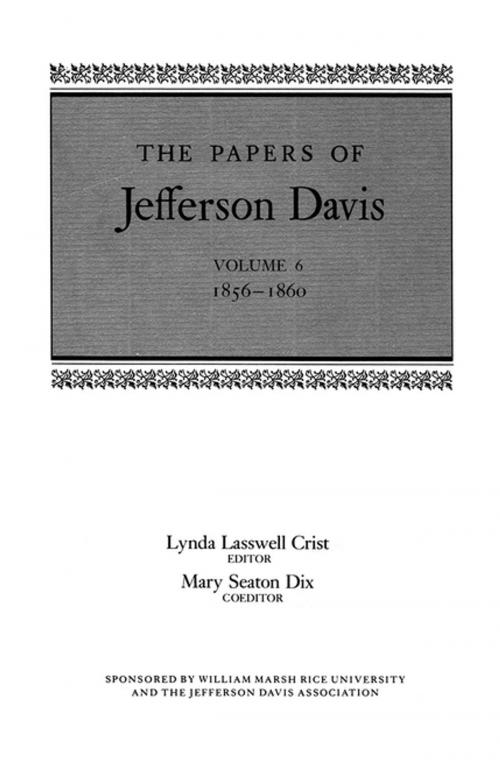The Papers of Jefferson Davis
1856–1860
Nonfiction, History, Americas, United States, Civil War Period (1850-1877), Reference & Language, Reference| Author: | Jefferson Davis | ISBN: | 9780807158777 |
| Publisher: | LSU Press | Publication: | April 1, 1989 |
| Imprint: | LSU Press | Language: | English |
| Author: | Jefferson Davis |
| ISBN: | 9780807158777 |
| Publisher: | LSU Press |
| Publication: | April 1, 1989 |
| Imprint: | LSU Press |
| Language: | English |
Volume 6 of The Papers of Jefferson Davis, spanning the five crucial years before 1861, chronicles Davis’ last year as secretary of war and his return to the Senate, capstone of his long career of public service to the United States. Volume 6 includes 116 letters printed in full with annotation, a calendar of over 6,000 items, and summaries of 53 recently discovered documents dating from 1845 through 1855, as well as illustrations and maps prepared especially for the volume.
Davis’ correspondence and his final report to Franklin Pierce mirror the concerns of his last months as head of the War Department—turmoil in Kansas, protection of western settlements, construction of the Washington Aqueduct, the Capitol extension and new dome, surveys for the Pacific Railroad, Indian relations, the camel experiment, army reorganization, and advances in weaponry.
All these issues followed Davis to the Senate in March, 1857, but other questions soon claimed equal attention. As debates on abolition, state rights, fugitive slaves, and slavery in the territories became more frequent and more divisive, Davis found himself a major spokesman for his region. He was caught up in the momentous events testing the nation during James Buchanan’s administration: “bleeding Kansas,” Preston Brook’s attack on Charles Sumner, John Brown’s raid on Harpers Ferry, the 1860 Democratic conventions, the election of a Republican president, and the secession of South Carolina. He debated at length with Stephen A. Douglas and others over “squatter sovereignty” and offered his own resolutions on the relations of states as the basis for the Democratic platform in 1860.
Personal correspondence gives revealing word pictures of Varina Davis and the children, the family’s sojourn in New England during the Summer of 1858, disastrous flooding at Brierfield in 1859, and Davis’ persistent, debilitating illnesses.
Volume 6 covers fateful years for the nation and for Jefferson Davis, a man moving toward a destiny that he is both creating and hoping to avoid.
Volume 6 of The Papers of Jefferson Davis, spanning the five crucial years before 1861, chronicles Davis’ last year as secretary of war and his return to the Senate, capstone of his long career of public service to the United States. Volume 6 includes 116 letters printed in full with annotation, a calendar of over 6,000 items, and summaries of 53 recently discovered documents dating from 1845 through 1855, as well as illustrations and maps prepared especially for the volume.
Davis’ correspondence and his final report to Franklin Pierce mirror the concerns of his last months as head of the War Department—turmoil in Kansas, protection of western settlements, construction of the Washington Aqueduct, the Capitol extension and new dome, surveys for the Pacific Railroad, Indian relations, the camel experiment, army reorganization, and advances in weaponry.
All these issues followed Davis to the Senate in March, 1857, but other questions soon claimed equal attention. As debates on abolition, state rights, fugitive slaves, and slavery in the territories became more frequent and more divisive, Davis found himself a major spokesman for his region. He was caught up in the momentous events testing the nation during James Buchanan’s administration: “bleeding Kansas,” Preston Brook’s attack on Charles Sumner, John Brown’s raid on Harpers Ferry, the 1860 Democratic conventions, the election of a Republican president, and the secession of South Carolina. He debated at length with Stephen A. Douglas and others over “squatter sovereignty” and offered his own resolutions on the relations of states as the basis for the Democratic platform in 1860.
Personal correspondence gives revealing word pictures of Varina Davis and the children, the family’s sojourn in New England during the Summer of 1858, disastrous flooding at Brierfield in 1859, and Davis’ persistent, debilitating illnesses.
Volume 6 covers fateful years for the nation and for Jefferson Davis, a man moving toward a destiny that he is both creating and hoping to avoid.















